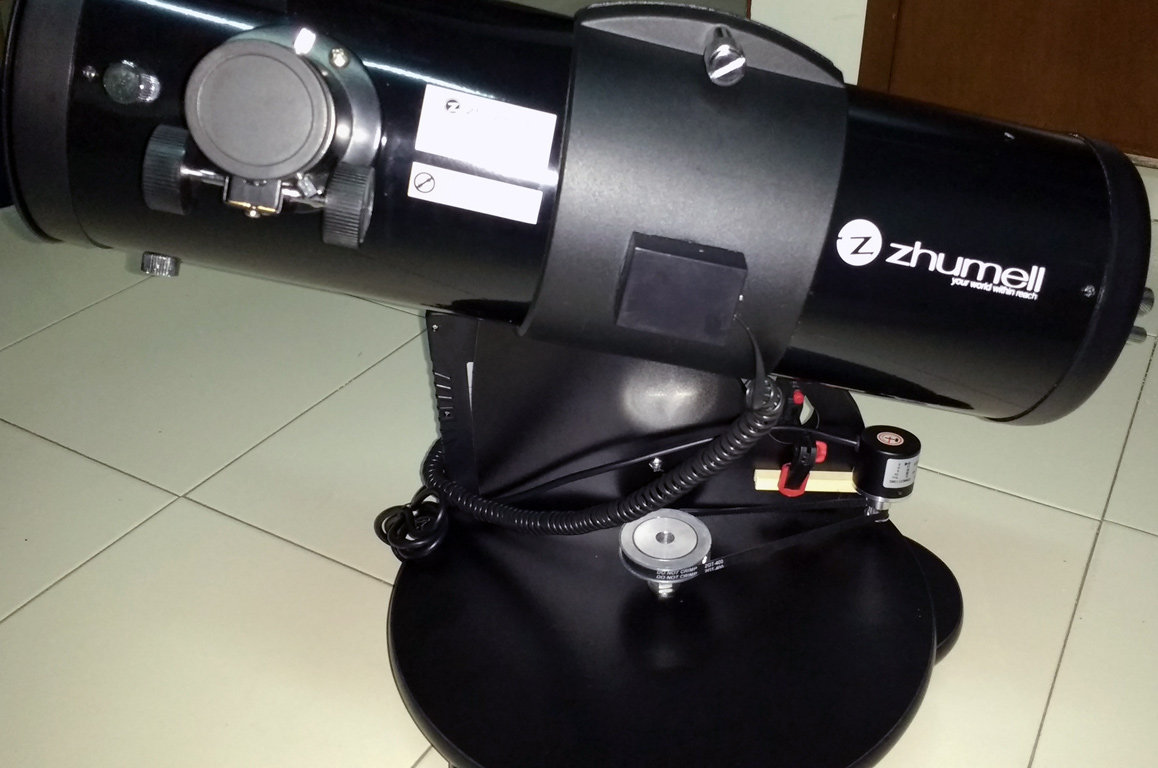Amateur astronomers want to know where their telescope is pointing at. For this reason, many commercial telescopes come equipped with "push to" or "go to" features, often based on high precision optical rotary encoders attached to the telescope mount, and a hand control device with a database of coordinates of thousands of stars and other sky objects.
There are also commercial Digital Setting Circles, which are kits sold for telescope owners to adapt to their existing telescope, in order to give it "push to" features. Commercial DSCs are very accurate, mostly based on optical encoders, and usually cost a few hundred dollars.
This project is an implementation of a simple Digital Setting Circles, that evolves from my previous DSC project, but now using an inexpensive optical encoder (and GT2 timing belt+gear) instead of the magnetometer.
This DSC achieves the following:
- Easy and inexpensive to build, for a DIY maker or Arduino enthusiast.
- Can be attached to dobsonian mounts, included tabletops.
- High resolution: 10.200 counts per revolution (compare to the 9.216 counts per revolution of the Orion XT 10i, or the 11.748 cpr of SkyWatcher dobsonians).
- Instead of a wired handheld control, it communicates with Android/iOS apps like Skysafary 5 (plus or pro), DSC-Browser and others via WiFi.
My prototype is a removable version installed on a Zhumell Z114 tabletop:
You can see I'm using a woodworking clamp to affix the encoder in the position required to have proper tension in the timing belt. This way, the DSC is very easy to remove from the scope without leaving any permanent marks.
- $3.05 NodeMCU ESP8266 development board (version 12E) link
- $4.20 LSM303DLHC sensor module link
- $17.99 Signswise 600p/r Incremental Rotary Encoder DC5-24v 6mm shaft link
- $9.99 85 teeth GT2 timing pulley 10mm shaft link
- $0.82 20 teeth Gt2 timing pulley 6.35mm shaft link
- $1.05 GT2 timing belt (length depends on your telescope size), I used 400mm for the Z114 link
Subtotal parts cost: $37.1
Add some solder, cables, a 5V power source, a couple resistors, and screws for attaching the encoder to the base whichever way you want. A maker can build this DIY DSC for much less than the cost of two high resolution optical encoders and a NexusDSC.
The key to this new version of my DSC is the use of an inexpensive optical encoder for azimuth. The $17.99 encoder I used has 600ppr, which using quadrature produces 2400 counts per revolution, which would not be engough for a DSC, but using GT2 timing pulleys of 85 and 20 teeth (for a ratio of 4.25 to 1) we can now get 10200 counts per revolution on azimuth, for just a fraction of the price of a 10k encoder.
This is how the GT2 pulleys and belt look in the base of my Z114:
For simplicity and cost savings, altitude is driven by the same high-res accelerometer I used in my previous DSC, the LSM303DLHC which has more than enough resolution to match the azimuth encoder.
The microcontroller is a very inexpensive ESP8266, I used the nodeMCU variant which seems to be tolerant of the 5V inputs from the encoder. You can use any 5V power source you want, I'm using a power bank:
The large box is the power bank, the smaller box is housing the main circuit with the ESP8266.
The circuit, is very very simple:
Please note that I'm powering the LSM303DLHC from the NodeMCU 3V3 line, not from the 5V power supply using the Vin pin.
I've used this DSC successfully with my Z114 telescope (from now on, my Z114i). The accuracy is on par to that of my Skywatcher goto mount.
To use it you just connect your tablet to the access point created by the device, configure SkySafari 5 Plus (or Deep Sky Browser, or other program) to connecto the IP address of the device (by default: 1.2.3.4 port 4030), select "Basic Encoders" for Telescope type, and voilà! SkySafari is now connected to your telescope.
To use the source code released here you will need the arduino IDE to compile and deploy it to your microcontroller, and you'll need to install the Encoder Library by Paul Stoffregen (I used version 1.4.1), and the LSM303 Library by Pololu (I used version 3.0.1).
You can ask questions or provide feedback here.



